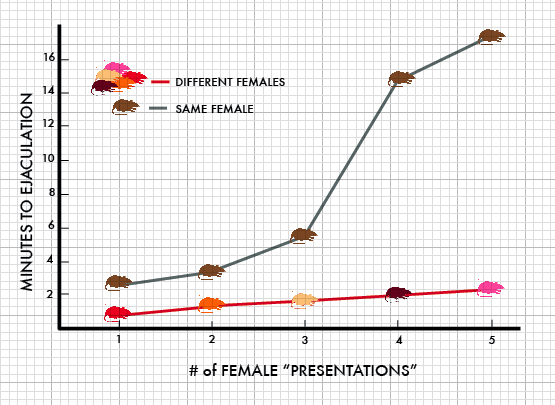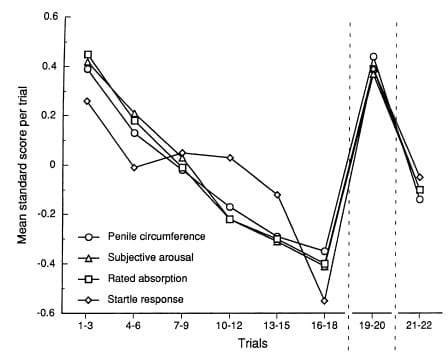Without the Coolidge Effect there would be no Internet porn

The Coolidge Effect is an ancient biological program that can override your sluggish contentment after orgasm if there are new mates begging to be fertilized. Without it, there would be no Internet porn. This neurological mechanism perceives each new erotic possibility—including those on your screen—as a valuable genetic opportunity, and jolts you into action with potent neurochemicals.
What happens when you drop a male rat into a cage with a receptive female rat? First, there’s a sexual frenzy. Then, the male progressively tires of that particular female. Even if she wants more he has had enough. However, replace the original female with a fresh one, and presto! The male revives and gallantly struggles to fertilize her. You can repeat this process with fresh females until he nearly dies of exhaustion. Scientists know this phenomenon as the Coolidge Effect and it has been observed in females, too.
Dopamine
The rat goes after each new female because of surges of dopamine (a neurochemical) in his brain. Nothing natural comes close to releasing as much dopamine as sex, because our genes want to make their way into the future above all else. Dopamine surges command the rat to leave no willing mate unfertilized.
Dopamine is the “gotta get it!” neurochemical behind all motivation. Without it we wouldn’t bother to court, pursue climax, or even eat. When dopamine drops, so does motivation. Dopamine is also the hook in all addictions. An addict’s brain grows less sensitive to it, and thus, paradoxically, more desperate for it.
Back to the rat. Following each copulation with the same female his reward circuitry squirts less and less dopamine. Consider the above graph. The fifth time a rat copulates with the same female it takes him 17 minutes to get off. Ejaculation time increases as dopamine released decreases. But if he keeps switching to novel females, he can do his duty very quickly all five times. His brain renews his virility with strong squirts of dopamine in response to each new partner. *
Pair bonding
Unlike rats, humans are pair bonders. We’re wired, on average, to raise offspring together—and to find a fair amount of contentment in our unions (potentially). But the Coolidge Effect lurks in us, too, and awakens when duty trumpets loudly enough. I once had a conversation with a man who had grown up in Los Angeles. “I quit counting at 350 lovers,” he confessed, “and I guess there must be something terribly wrong with me because I always lost interest in them sexually so quickly. Some of those women are really beautiful, too.”
At the time of our chat his third wife had just left him for a Frenchman and he was discouraged. She had lost interest in him.
Internet porn: the Coolidge Effect on twin turbos
Online erotica can goad a user relentlessly. Endless novel “mates” keep dopamine surging. One guy noticed how novelty was the hook:
I collected a lot of porn. I thought I was amassing some wonderful database of pleasure. But I can’t remember ever actually going back. The compelling part is the new star, the novel video, the novel act.
Not surprisingly, numerous studies employing porn show that rats and humans aren’t that different when it comes to response to novel sexual stimuli. For example, when Australian researchers displayed the same erotic film repeatedly, test subjects’ penises and subjective reports both revealed a progressive decrease in sexual arousal. The “same old same old” just gets boring (habituation, which indicates declining dopamine).
After 18 viewings—just as the test subjects were nodding off—researchers introduced novel erotica for the 19th and 20th viewings. Bingo! The subjects and their penises sprang to attention. (Yes, women showed similar effects.)

Scientists have also learned that masturbating to a novel pornstar increases ejaculate volume and motile sperm (compared with masturbating to a familiar actress). Also, the time it took to ejaculate decreased significantly. In short, sexual novelty translates into more fertile semen and faster ejaculation, making any “extra-pair couplings” more efficient, and more costly.
Novel sexual partners
The Coolidge effect is also characterized as greater reward circuit activity when exposed to a novel sexual partner. Dopamine surges for anything novel—especially if it’s sexual. Research confirms anticipation of reward and novelty amplify one another to increase excitement and rewire the limbic brain. This primitive part of the brain doesn’t care if you’ve already had more than enough sex; it wants genetic results. For example, Sooty, a male guinea pig, broke into a cage of twenty-four females. For days after he was apprehended, he was knackered. (Research on other rodents shows that full recovery of the brain takes about seven days, and research on humans also reveals a post-ejaculation cycle of at least seven days.)
Sooty’s genes were happy though; he fathered 42 baby pigs. Such opportunities were once rare for males of all species, but the Coolidge Effect insures that should an occasion arise, males will disregard their natural limitations and go at it till they drop.
Recovery time
Obviously, males need time to recover their potency and vigor after overriding their sexual satiation mechanisms with dopamine/novelty. Yet what happens to today’s Internet porn users? How many are overriding their innate sexual satiation mechanisms—without giving themselves weeklong timeouts to recover? There is always another enticing “mate” demanding to be fertilized. Tellingly, when men with porn-induced erectile dysfunction quit using porn they experience an unnerving “flatline.” Once they lift their foot off the gas, their libido takes a nap that lasts for weeks—an extreme version of Sooty’s recovery period.
Novelty can make mates seem less attractive
Dopamine isn’t just released in response to novelty. When something is more arousing than anticipated the brain’s reward circuitry releases dopamine and fires like crazy. Internet porn always offers something unexpected, something kinkier.
In contrast, sex with your sweetheart is not always better than expected. Nor does it offer endless variety. It offers other kinds of more soothing rewards. Sadly, a primitive part of your brain assumes quantity of dopamine equals value of activity even when it doesn’t.
 Bottom line: Too much synthetic stimulation can make your mate look like cold oatmeal. According to a 2007 study, mere exposure to a series of images of sexy females causes a man to devalue his real-life partner. He rates her lower not only on attractiveness, but also on warmth and intelligence. Also, after pornography consumption, subjects in a 1988 study reported less satisfaction with their intimate partner—including the partner’s affection, appearance, sexual curiosity, and performance.
Bottom line: Too much synthetic stimulation can make your mate look like cold oatmeal. According to a 2007 study, mere exposure to a series of images of sexy females causes a man to devalue his real-life partner. He rates her lower not only on attractiveness, but also on warmth and intelligence. Also, after pornography consumption, subjects in a 1988 study reported less satisfaction with their intimate partner—including the partner’s affection, appearance, sexual curiosity, and performance.
Even a few short decades ago, sex with a warm, receptive mate generally provided more dopamine than masturbating (again) to a sticky Playmate. After all, once Miss July was thoroughly “fertilized,” you got less of a dopamine hit from her airbrushed curves. You had to wait for Miss August. Then came adult stores. But how many times could you get off to the same video before it was time to fetch a new one? (Paying for porn…how quaint.)
The never-ending hunt
Today’s Internet porn, in contrast, offers endless fireworks at the click of a mouse. You can hunt (another dopamine-releasing activity) for hours, and experience more novel sex partners every ten minutes than your hunter-gatherer ancestors experienced in a lifetime. Dopamine hit after dopamine hit can induce a drug-like altered state. (Cocaine, for example, owes its high to excess dopamine circulating in the brain.) It’s powerful enough to override your brain’s normal sexual satiation mechanisms after orgasm.
I have been masturbating to static porn images since I was a teenager. I never had a problem with ED until around 6 years ago. The problem began with access to free streaming Internet porn. As connection speed increased, so has the overwhelming availability to view as much as I could handle. I ended up rewiring my brain to get aroused only by masturbating to porn. I am in a relationship with a wonderful, gorgeous woman for the last 4 years and have notice a gradual decline in my libido and a rise in ED.
Harmless porn?
You often hear that, “Porn has been around forever, so it must be harmless.” Yet this claim is meaningless once novelty’s powerful effect on the brain is fully understood. Today’s 24/7 Internet porn with unlimited genres doesn’t simply allow you to quench your sexual appetite. It allows you to go far beyond that appetite—perhaps with unfortunate consequences. For some, masturbating to Internet porn becomes more compelling than sex:
Far from just “rubbing off,” we chronic masturbators generally engage in a practice we call “edging“: bringing ourselves to the brink of orgasm repeatedly, without ejaculation. We sustain extremely high levels of sexual arousal literally for hours. I am an active participant in several masturbation-focused Internet groups, and moderator of one.
Many of us go so far as to abandon partner-sex, even while the partner remains available and willing. We’ve also coined the term “copulatory impotence” for the common phenomenon of being able to get it up to Internet porn, but not for a partner.
Whoa! An evolutionary mechanism calculated to increase offspring and their genetic variety can drive porn users away from real mates? Yes, because the mechanism runs on dopamine. Your brain assumes that if something gets you really hot, it has to be an honest-to-god fertilization opportunity (even worth taking dangerous risks for, back in the day).
Is the Coolidge Effect leading to the “demise of guys?”
Unless you understand the Coolidge Effect’s hidden brain mechanism, which urges you to step on the gas even when you’ve had more than enough, it’s hard to connect an insatiable libido with the fact that your brain is growing less responsive due to dopamine overload. After all, it can feel like your libido is insatiable. The situation is paradoxical because the powerful aphrodisiac of more porn at first feels like the answer to any sexual performance woes.
The reality, however, is that neurochemically-induced dissatisfaction deep in the brain may well be fueling your urge to seek more stimulation. A clue that your libido thermostat has been readjusted would be that you need Internet porn to get a healthy erection or get off. (Yes, back in the day, guys easily masturbated to climax with no porn.)
Other signs would be increased restlessness, irritability and dissatisfaction, desire for kinkier sex, finding your mate less attractive or compelling than the Internet, or a need for more extreme material. Experts call such effects “tolerance.” They can indicate an addiction process at work in the brain.
Philip Zimbardo
For example, watch this five-minute TED talk ‘The Demise of Guys?’ by famous psychologist Philip Zimbardo as he describes how “arousal addiction” is adversely affecting an entire generation. Said one recovering porn user:
I personally suffered from much of what he talks about in this video. Since stopping porn the depersonalization has dwindled. I crack witty jokes and speak fluently without thinking about what I’m saying or worrying about how others will react. My relationship with my girlfriend has also become more personal as some of the walls I put up are now crumbling. Excellent video.
Much of the trouble starts with the sneaky, novelty-driven Coolidge Effect—nature’s whip for insuring that you do your duty if receptive mates are around, even if you have already had enough sex. Your genes don’t care what best eases your stress, protects your health, or sustains your relationship. They automatically urge you to grab the option that releases the most dopamine. When an e-hottie beckons, your brain assumes you’re in the gene-spreading business. That’s top priority—regardless of collateral damage to you.
* The data in the first graph above was taken from research on rams, not rats—so rams should be pictured instead. However, the same effect has also been observed in rats.
- List of studies showing habituation to porn in humans and habituation to sexual partners in animals
- New: Men Ejaculate Larger Volumes of Semen, More Motile Sperm, and More Quickly when Exposed to Images of Novel Women (2015)
- List of Studies Find Escalation (and Habituation) in Porn Users
- Nucleus accumbens dopamine increases sexual motivation in sexually satiated male rats (2018)